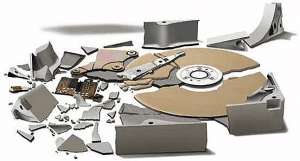 Always a pain, but at least with my FreeNAS set-up, it’s never too much of a worry knowing I can tolerate 2 failed drives without any loss of data, whilst also having the safety net of a full local backup.
Always a pain, but at least with my FreeNAS set-up, it’s never too much of a worry knowing I can tolerate 2 failed drives without any loss of data, whilst also having the safety net of a full local backup.
To be honest, the drive in question hadn’t actually failed but had reported SMART errors for a month or so. It started with just 8 unrecoverable sectors, which I tend to ignore for a short time. Only when it jumps above 8 do I take action, which it did yesterday.
Having 14 x 4TB drives in play, it pays to have one standing by so it was simply a case of taking the failing drive ‘offline’ and then shutting down the server and swapping them over. It was done in less than 15 minutes and after rebooting and ‘replacing’ the old drive with the new one it automatically starts the resilvering process, which is the bit that takes the time. Not too bad really, as less than 24 hours later everything is back as it was and I have another Seagate HDD to RMA.
I chose Seagate drives as I’d had a few issues previously with Western Digital drives and those are the two that offer a decent price point whilst providing NAS specific drives. I wouldn’t go with standard desktop drives, at least not with 5 and 9 drives in my machines, and for the extra money, the NAS drives tend to offer a longer warranty period (3 or 5 years).
Which is good, as this will be the 4th Seagate ST4000VN000 (4TB NAS HDD) that I’ve RMA’ed over the past few years. Never had any problems, other than it costing around £5 to send it back. I normally have a replacement within 10-14 days so am ready for the next time.
I think the warranty on the drives in my backup machine probably expire this year (some might have already) so when I come to replace them it will be with larger capacity drives (probably 6TB) as the price is starting to drop on these now. The drives in my main FreeNAS machine are good through this year, and start to expire through 2018 as they were bought at different times. I’ll probably do the same with those, although I’m still undecided about building a new machine and using the current one as the backup. Either way, the backup will have fewer disks so the higher capacity makes sense.
Without the levels of redundancy and/or backup, a failed drive can be a really horrible experience, often ending in the loss of irreplaceable data. So this is really just a gentle reminder that if you don’t have one in place already, sort out a basic disaster recovery plan and rest easy the next time a drive is about to, or actually, kicks the bucket!
Just a quick update! The replacement drive arrived back today, so exactly 14 days from swapping it out. Not bad really, as I didn’t return to Seagate for about 4-5 days after that.

Recent Comments